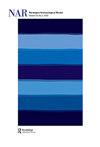Strength in Weakness
IF 0.8
3区 历史学
0 ARCHAEOLOGY
引用次数: 0
Abstract
Gavin Lucas and Christopher Witmore have written a thoughtful, engaging and well argued article. As with their previous work, their arguments encourage the reader to think about the nature and practice of archaeology in new ways. They raise questions about how we practice archaeology that are quite simple but quite profound. In this brief response, I want to respectfully differ over two aspects of their overall thesis. I am not persuaded that there is, or has been, a decisive move away from what Lucas and Witmore term paradigmatic thought and strong theory. First, as they point out, in some circles strong theory is stronger than ever: they mention Kristiansen and others, and could have pointed to Kintigh et al. (2014), which was a quite explicit attempt to impose a research agenda on the discipline, and to Kohler et al. (2017). The co-existence of stronger-than-strong theory of this kind with the ‘weaker’ approaches and sensibilities advocated by Lucas and Witmore might suggest not a shift from one mode to another, but rather a fragmentation in archaeological thinking and practice. Alternatively, it might suggest that we are mistaken in seeing strong theory and weak theory as competing. I suggest that we might see strong and weak theory instead as mutually interdependent. Weak theory is only possible, can only carve out an intellectual space for itself, within a wider paradigm that is broadly post-positivist and dare I say it postmodern. Such a comment may sound out-of-date but I think it still retains validity. I suggest that strong theory may not be overtly articulated within the sort of account offered by Lucas and Witmore but it is very much present nevertheless. Consider the very practical question of how it is that Witmore came to be doing archaeological research in Napflion in the first place. To obtain the travel and project funds, he must have written a formal proposal complete with research design. Explicitly or implicitly, such documents tend to be framed around Big Questions and to lay out a formal structure of archaeological research in which the collection of evidence is brought to bear on moreor-less paradigmatic questions. I have never seen or refereed a research proposal that foregrounded a process of ‘slow archaeology’ or which proposed the sort of archaeological process presented by Lucas and Witmore. I am pointing here not just towards the interdependence of strong and weak theory, but also towards a more basic disconnect between what archaeologists say they do and what they actually do. Archaeologists (some? many?) do, in practice, spend much of their time engaging in the sort of slow archaeology described and dissected in the Napflion and pottery analysis vignettes. This kind of practice, however, is systematically written out of most theoretical accounts. It is a major achievement of constructivist approaches to have written it back in. I have a second respectful difference, which is the degree to which a shift to weak theory is dependent on an object-oriented弱中求强
加文·卢卡斯(Gavin Lucas)和克里斯托弗·威特莫尔(Christopher Witmore)写了一篇深思熟虑、引人入胜、论点充分的文章。与他们之前的工作一样,他们的论点鼓励读者以新的方式思考考古学的本质和实践。它们提出了关于我们如何实践考古学的问题,这些问题很简单,但也很深刻。在这简短的回应中,我想在他们整体论文的两个方面有所不同。我不相信Lucas和Witmore所说的范式思想和强有力的理论已经或已经发生了决定性的转变。首先,正如他们所指出的,在一些圈子里,强大的理论比以往任何时候都更强大:他们提到了克里斯蒂安森和其他人,本可以指出Kintigh等人(2014),这是一个非常明确的尝试,旨在将研究议程强加给该学科,以及Kohler等人(2017)。这种强于强的理论与Lucas和Witmore所倡导的“弱”的方法和情感的共存可能并不意味着从一种模式向另一种模式的转变,而是考古思维和实践的碎片化。或者,这可能表明我们错误地将强理论和弱理论视为竞争。我建议我们可以把强理论和弱理论看作是相互依存的。弱理论是唯一可能的,只能在一个更广泛的后实证主义范式中为自己开辟一个知识空间,我敢说它是后现代的。这样的评论听起来可能已经过时了,但我认为它仍然有效。我认为,强有力的理论可能不会在Lucas和Witmore提供的那种描述中公开阐述,但它仍然存在。想想一个非常实际的问题,Witmore最初是如何在Napflion进行考古研究的。为了获得差旅和项目资金,他必须写一份正式的提案,并完成研究设计。无论是明示还是暗示,这些文件都倾向于围绕大问题展开,并为考古研究提供一个正式的结构,在这个结构中,证据的收集或多或少涉及到一些典型的问题。我从未见过或引用过一项研究提案,该提案预测了“缓慢考古”的过程,或提出了卢卡斯和威特莫尔提出的那种考古过程。我在这里不仅指出了强理论和弱理论的相互依存性,还指出了考古学家所说的他们所做的和他们实际所做的之间更基本的脱节。在实践中,考古学家(一些人?很多人?)确实把大部分时间花在了Napflion和陶器分析小插曲中描述和剖析的那种缓慢的考古学上。然而,这种实践是从大多数理论叙述中系统地写出来的。把它写回来是建构主义方法的一个重大成就。我还有第二个尊重的区别,那就是向弱理论的转变在多大程度上依赖于面向对象
本文章由计算机程序翻译,如有差异,请以英文原文为准。
求助全文
约1分钟内获得全文
求助全文
来源期刊

Norwegian Archaeological Review
ARCHAEOLOGY-
CiteScore
2.10
自引率
0.00%
发文量
13
期刊介绍:
Norwegian Archaeological Review published since 1968, aims to be an interface between archaeological research in the Nordic countries and global archaeological trends, a meeting ground for current discussion of theoretical and methodical problems on an international scientific level. The main focus is on the European area, but discussions based upon results from other parts of the world are also welcomed. The comments of specialists, along with the author"s reply, are given as an addendum to selected articles. The Journal is also receptive to uninvited opinions and comments on a wider scope of archaeological themes, e.g. articles in Norwegian Archaeological Review or other journals, monographies, conferences.
 求助内容:
求助内容: 应助结果提醒方式:
应助结果提醒方式:


